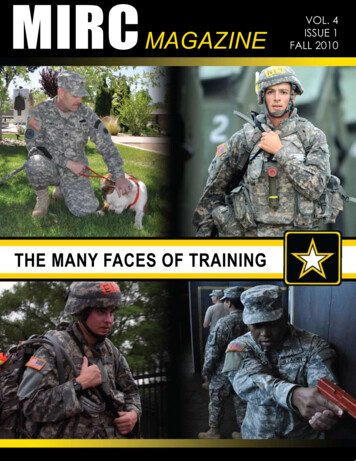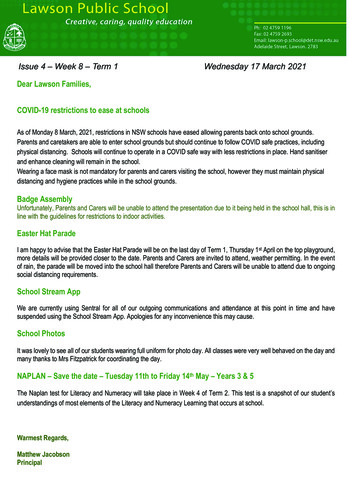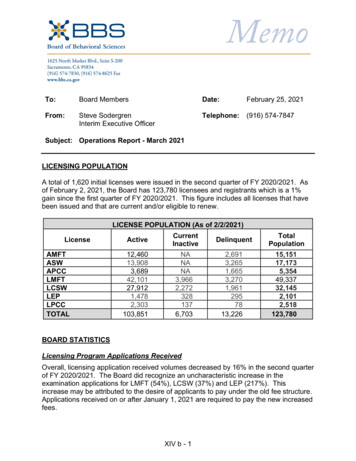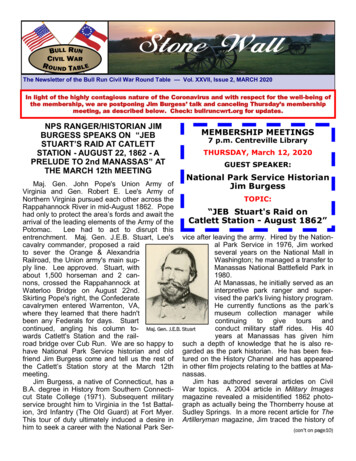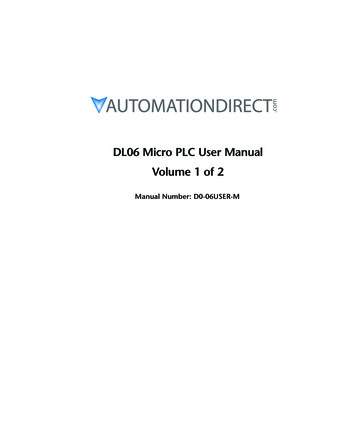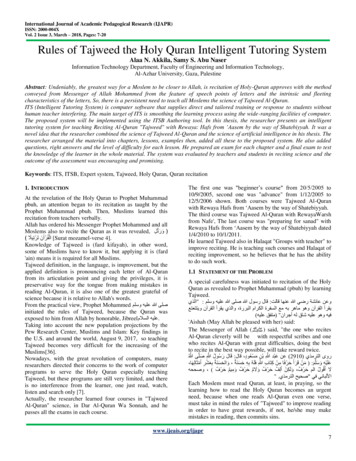
Transcription
International Journal of Academic Pedagogical Research (IJAPR)ISSN: 2000-004XVol. 2 Issue 3, March – 2018, Pages: 7-20Rules of Tajweed the Holy Quran Intelligent Tutoring SystemAlaa N. Akkila, Samy S. Abu NaserInformation Technology Department, Faculty of Engineering and Information Technology,Al-Azhar University, Gaza, PalestineAbstract: Undeniably, the greatest way for a Moslem to be closer to Allah, is recitation of Holy-Quran approves with the methodconveyed from Messenger of Allah Mohammed from the feature of speech points of letters and the intrinsic and fleetingcharacteristics of the letters, So, there is a persistent need to teach all Moslems the science of Tajweed Al-Quran.ITS (Intelligent Tutoring System) is computer software that supplies direct and tailored training or response to students withouthuman teacher interfering. The main target of ITS is smoothing the learning process using the wide-ranging facilities of computer.The proposed system will be implemented using the ITSB Authoring tool. In this thesis, the researcher presents an intelligenttutoring system for teaching Reciting Al-Quran "Tajweed" with Rewaya: Hafs from ‘Aasem by the way of Shatebiyyah. It was anovel idea that the researcher combined the science of Tajweed Al-Quran and the science of artificial intelligence in his thesis. Theresearcher arranged the material into chapters, lessons, examples then, added all these to the proposed system. He also addedquestions, right answers and the level of difficulty for each lesson. He prepared an exam for each chapter and a final exam to testthe knowledge of the learner in the whole material. The system was evaluated by teachers and students in reciting science and theoutcome of the assessment was encouraging and promising.Keywords: ITS, ITSB, Expert system, Tajweed, Holy Quran, Quran recitation1. INTRODUCTIONAt the revelation of the Holy Quran to Prophet Muhammadpbuh, an attention began to its recitation as taught by theProphet Muhammad pbuh. Then, Muslims learned thisrecitation from teachers verbally.Allah has ordered his Messenger Prophet Mohammed and allMoslems also to recite the Quran as it was revealed, ﴿ َو َزحِّ ِم [ ْانمُسْ آٌََ حَسْ حِ ا Surat mozamel-verse 4].﴾ ًُل Knowledge of Tajweed is (fard kifayah), in other word,some of Muslims have to know it, but applying it is (fard'ain) means it is required for all Muslims.Tajweed definition, in the language, is improvement, but theapplied definition is pronouncing each letter of Al-Quranfrom its articulation point and giving the privileges, it ispreservative way for the tongue from making mistakes inreading Al-Quran, it is also one of the greatest grateful ofscience because it is relative to Allah's words.From the practical view, Prophet Mohammed طهً هللا عهُه وسهى initiated the rules of Tajweed, because the Quran wasexposed to him from Allah by honorable, Jibreel عهُه انسًلو .Taking into account the new population projections by thePew Research Center, Muslims and Islam: Key findings inthe U.S. and around the world, August 9, 2017, so teachingTajweed becomes very difficult for the increasing of theMuslims[36].Nowadays, with the great revolution of computers, manyresearchers directed their concerns to the work of computerprograms to serve the Holy Quran especially teachingTajweed, but these programs are still very limited, and thereis no interference from the learner, one just read, watch,listen and search only [7].Actually, the researcher learned four courses in "TajweedAl-Quran" science, in Dar Al-Quran Wa Sonnah, and hepasses all the exams in each course.The first one was "beginner’s course" from 20/5/2005 to10/9/2005, second one was "advance" from 1/12/2005 to12/5/2006 shown. Both courses were Tajweed Al-Quranwith Rewaya Hafs from ‘Aasem by the way of Shatebiyyah.The third course was Tajweed Al-Quran with RewayaWarshfrom Nafe', The last course was "preparing for sanad" withRewaya Hafs from ‘Aasem by the way of Shatebiyyah dated1/4/2010 to 10/1/2011.He learned Tajweed also in Halaqat "Groups with teacher" toimprove reciting. He is teaching such courses and Halaqat ofreciting improvement, so he believes that he has the abilityto do such work.1.1 STATEMENT OF THE PROBLEMA special carefulness was initiated to recitation of the HolyQuran as revealed to Prophet Muhammad (pbuh) by learningTajweed.ٌ "انر : لال زسىل هللا طهً هللا عهُه وسهى : وعٍ عائشت زضٍ هللا عُها لانج وانرٌ َمسأ انمسآٌ وَخخعخع ، َمسأ انمسآٌ وهى ياهس به يع انسفسة انكساو انبسزة ) فُه وهى عهُه شاق نه أجساٌ" (يخفك عهُه 'Aishah (May Allah be pleased with her) said:The Messenger of Allah ( )ﷺ said, "the one who recitesAl-Quran cleverly will be with respectful scribes and onewho recites Al-Quran with great difficulties, doing the bestto recite in the best way possible, will take reward twice. طههً ه لَا َل َزسُى ُل ه : لال ، هللاِ بٍْ َي ْسعُى ٍد ) عٍ َعبْد ه 0192( ٌ زوي انخسير ُ هللا َ ِ هللا ب ه ، َوان َح َسَُتُ بِ َع ْش ِس أَ ْيثَانِهَا ، ٌ هللاِ فَهَهُ بِ ِه َح َسَُت ِ ( َي ٍْ لَ َسأَ َحسْ فاا ِي ٍْ ِكخَا : َعهَ ُْ ِه َو َسهه َى وطححه ، ) ٌ َونَ ِك ٍْ أَنِفٌ َحسْ فٌ َو ََل ٌو َحسْ فٌ َو ِيُ ٌى َحسْ ف ، ٌ ََل أَلُى ُل انى َحسْ ف " .ٌ األنباٍَ فٍ "طحُح انخسير Each Moslem must read Quran, at least, in praying, so thelearning how to read the Holy Quran becomes an urgentneed, because when one reads Al-Quran even one verse,must take in mind the rules of "Tajweed" to improve readingin order to have great rewards, if not, he/she may makemistakes in reading, then commits sins.www.ijeais.org/ijapr7
International Journal of Academic Pedagogical Research (IJAPR)ISSN: 2000-004XVol. 2 Issue 3, March – 2018, Pages: 7-20There are some of the difficulties to do that in the traditionalteaching: One teacher teaches many students, so he/shecannot care to every student. Some people learn slowly, with human teachersthere is no sufficient time. Shyness, hesitation and fear prevent some studentsfrom asking the teacher. Negligence of various background information ofstudents. Material is delivered with same teaching method forall students irrespective of various altitudes ofunderstanding. Not all learners understand with the same style ofteaching, some are visual learners, others are audiolearners. Referring to books of Tajweed take time and effort. There are students with special needs, so theycannot follow the teacher. Teachers are not available every time andeverywhere. Old age learners of Tajweed face psychologicaldifficulties with young teachers.The questions, which are posed to the learner are chosenrandomly from the system on the level reached.1.4 LIMITATIONSIn recitation of Quran, there are ten Qira'at, twenty riwayatand a lot of turuq as shown in Figure 1. This proposedsystem cover the first level of tajweed with Rewaya Hafsfrom ‘Aasem by the way of Shatebiyyah زواَت حفض عٍ عاطى بطسَك انشاطبُت .Figure 1: Qira'at, riwayat and turuqThe attribution of Hafs to Prophet Mohammed طهً هللا عهُه وسهى is shown in Figure 2.All these problems can be solved by the proposed ITSsystem. One-to-one teaching (one teacher for each student). Immediate feedback. Learner chooses any lesson freely depending ontheir knowledge. Available all the time.Teaching Tajweed material has special requirements,reading rules are not sufficient to learn, it needs audio andvideo to imitate correctly.1.2 OBJECTIVESThe aim of this thesis is to minimize the difficultiesfaced in learning Tajweed, such as giving more time to learn,remove fear, shyness from learner, demonstrating thespecific subject as needed, available all time anywhere andcreating the suitable environment for studying.1.3 SIGNIFICANCE OF THE STUDYThe proposed ITS system for teaching Tajweed Rules bindArtificial Intelligence and education, which achieves manyaspirations. One is matching the special needs of eachstudent; afford various techniques of the material and theuser interaction.The system adapts its model according to student’s responsesby giving questions of the suitable difficulty level for thestudent, and showing an explanation of mistakes to directhim/here what to study again. The student’s privacy isachieved including level of difficulty reached, scoreobtained.Figure 2: Attribution of Hafswww.ijeais.org/ijapr8
International Journal of Academic Pedagogical Research (IJAPR)ISSN: 2000-004XVol. 2 Issue 3, March – 2018, Pages: 7-20 2. INTELLIGENT TUTORING SYSTEMS BACKGROUND2.1 ITS DEFINITIONThe technological revolution indicates that the dependenceof traditional education (which lectures are static in time andspace) will decrease gradually.Artificial intelligence, is the science making computers totake the place of the intelligence of human, with inmostunderstanding of knowledge, mainly representation andreasoning about "how to" knowledge, like proceduralknowledge.Cognitive science, or research into understanding howpeople act intelligently, leads to a deeper understanding ofhow people think, solve problems, and learn.AI and cognitive science, two sides of a single coin that is,understanding the nature of intelligent work, in which entityis obvious.Often, AI techniques are used to build software models ofcognitive processes, while the results of cognitive science areused to develop more artificial intelligence techniques toemulate human behavior.AI techniques are used in education to model studentknowledge, academic subjects, and teaching approaches.One-on-one tutoring is well documented as the best way tolearn [35]. Necessary hardware and software.Students work on personal computers or withsophisticated servers managed within the schoolzone.Intelligent tutors know how to teach.Academic materials stored in intelligent systems arenot just statements about the subject. Instead, theseprograms contain qualitative examples of each areato be taught, including things and processes thatdistinguish trends and causal relationships betweensubjects.2.4 ITS ARCHITECTUREThe architecture of ITS system contains domain modelwhich contains the material to be educated, pedagogical(expert) module which controls intelligently all the roles ofthe system, student model which contains the information ofthe learner, and user interface model which is thecommunication between the user and the application asshown in Figure 3.2.2 ITS OBJECTIVESThe field of artificial intelligence and education has manyobjectives: Adaptation on the requirements of individualstudents by using different styles in illustrations ofcontent, tracks through material, and a lot ofinterfaces. Recognizing how human emotion affects individualdifferences in learning, and the level to whichemotion, reasoning capability and gender impact. The field is derivative and innovative. It getstheories and approaches from related fields such asAI, cognitive science, and education; also it createsits own larger research questions. Teachers who use these tutors get insight intostudent learning progressions.2.3 SPECIAL NEEDS Intelligent tutors know individual studentdifferences.Tutors have background knowledge of each student,learning style, current needs and choice ofmultimedia materials at the appropriate teachinglevel and style.Students work independently or in teams.Groups of learners, separated by teachers easilymodify subjects, reproduce tutors, infinitely cost tostudents space and time, and cooperate on openended problems.Figure 3: The architecture of ITS system3. LITERATURE REVIEWWith the development of life and massive developmentof computer technology, the human has become dependenton computers applications heavily in most fields, especiallyin learning.3.1 PREVIOUS STUDEIESThere are many intelligent tutoring systems used inlearning; the following are some of them: The study of [2]Intelligent Tutoring System for Deaf Learners of WrittenEnglish. This system is called ICICLE (Interactive ComputerIdentification and Correction of Language Errors) which hasan error identification module to identify errors in a text, andresponse generation module to create dialogue. The study of[3] Student Modeling in an Intelligent Tutoring System forthe Passive Voice of English Language. In this system, if thestudent writes the solution to the posed question, the systemtests if it is right, else it attempts to analyze the mistake. Thestudy of [9] An Intelligent Tutoring System for TeachingGrammar English Tenses. A system designed to studentslearning English language. It shows English Grammartenses, and then produces questions automatically for thewww.ijeais.org/ijapr9
International Journal of Academic Pedagogical Research (IJAPR)ISSN: 2000-004XVol. 2 Issue 3, March – 2018, Pages: 7-20students to solve. The study of [4] An Intelligent TutoringSystem for Teaching the Grammar of the Arabic Language.The system is designed for students of elementary schools inthe fourth grade in Egypt. It supports the education processwith multimedia (sound, images and text). The study of [12]An Intelligent Tutoring System for Java ExpressionEvaluation. This system is called JEE-Tutor which teachesJava operator precedence and expressions for the studentslearning Java programming Language. The study of [13] AnIntelligent Tutoring System for Learning Java Object. Thissystem shows the material of Java objects and generatesquestions automatically for learner to answer. The systemcustomized upon the progress of each learner. The study of[14] Design and Development of an Intelligent TutoringSystem for C# Language. This system was designed; byusing ITSB authoring tool; to help learners to study C#programming language. The study of [15] A comparativestudy between Animated Intelligent Tutoring Systems(AITS) and Video-based Intelligent Tutoring Systems. Thisstudy showed that ITS developed the performance ofstudents in biology exams, and that Video-based IntelligentTutoring Systems are much better than Animated IntelligentTutoring Systems (AITS). The study of [16] Developing anintelligent tutoring system for students learning to programin C . This study developed an intelligent tutoring systemfor assistance of students registered in computer sciences 1(an introduction of C programming course) at the Facultyof Engineering and Information technology in Al-AzharUniversity.Furthermore other intelligent tutoring systems such as elearining [17], database [18, 19, 20, 21], biology [22, 23],and teaching Java Programming language [1]. An excellenteffort was done in Book of Tajweed Rules of the Qur'an PartOne, by Kareema Carol Czereepinski, 2000 [5], but learnercan read only without participating or checking what he/sheunderstand of the material. Automated tajweed checkingrules engine for Quranic learning 2013 [8], very good workbut was tested only on sora al-fatiha. Most of the techniquesof teaching Tajweed are written like books to read, videos towatch, sounds to hear, and all these make person a receiveronly; it means that there is no participation of the learner,and there is no way to test what one understand from thelessons. A very good starting point to teach Tajweed is inpaper titled "Teaching the Right Letter Pronunciation inReciting the Holy Quran Using Intelligent Tutoring System"[11]. The researcher is one of the two authors - but it wasdesigned to teach one subject only in Tajweed "Tafkhim andTarqiq in TAJWEED" the Holy Quran, Rewaya: Hafs from‘Aasem.3.2 COMMENTS ABOUT PREVIOUS STUDIESAfter looking at aforementioned studies, the researcherdid not find any study that uses the new idea of intelligenttutoring system. So, the proposed system is considered to bethe first one that combines the intelligent tutoring system andTAJWEED the Holy Quran.4. RESEARCH METHODOLOGY4.1 METHODOLOGYThese steps are followed:1. Gather data of rules of Tajweed with Rewaya: Hafsfrom ‘Aasem by the way of Shatebiyyah [6], [24],[25], [28], [29], [30].2. Organize lessons.3. Dividing the material into chapters containingappropriate lessons.4. Add the chapters and the lessons to the proposedsystem.5. Prepare examples to each lesson.6. Add the examples to the proposed system withlinkage to the appropriate lesson.7. Using text, graphic [26], sound and video inexplaining the material.8. Cutting parts of videos (Dr. Ayman Rushdi Swid[27], Dr. Mohammad Isam Al Quda [37], andSheikh Ahmed Mohamed Amer [38]) and audios ofrecorded materials for explaining the rightpronunciation in special cases.9. Prepare questions for each lesson (with difficultylevels).10. Prepare exams for each chapter (with difficultylevels).11. Add the questions, answers with style (True/False)or (multiple choice) to the proposed system.12. Execute and test the system.13. Let teachers and learners use the system, and taketheir feedback with a questionnaire.14. Check the system again and again depending on thefeedback gained.The researcher used the following various materials toenhance the style of teaching: Peom of Jazaria which is considered as one of theimportant poems in the science of Tajweed. It gotthe attention of scientists and specialists since it wasorganized by the Imam of readers Abu HassanMohammed bin al-Jazri[31]. The poem of Tohtat Al-Atfal was written by SheikhJamzoury containing some of the rules of Tajweedin 1198 Hijri[32]. The book Al-Nashr in the ten Qira'at of Ibn Al-Jazriis ranked as one the most helpful of books inTajweed. Ibn al-Jazri addressed all the correct waysof the ten readings, and this book is the essence ofbooks written by Ibn al-Jazri in Tajweedscience[33]. Mistakes in audio recordings of the Holy Quran andways of treatment, Dr. Abdulrahman YousefAhmed Al-Jamal. Haifa Abdelraouf Ibrahimwww.ijeais.org/ijapr10
International Journal of Academic Pedagogical Research (IJAPR)ISSN: 2000-004XVol. 2 Issue 3, March – 2018, Pages: 7-20Radwan. The research was presented in the FirstInternational Scientific Conference, The HolyQuran and its role in addressing the issues of thenation organized by Center of the Holy Quran andIslamic Dawa, Faculty of the fundamentals ofreligion - Islamic University – Gaza , 16, 17December 2008[34].4.2 ITS AUTHORING LANGUAGEThe researcher used the Intelligent Tutoring SystemBuilder (ITSB) tool to assemble an intelligent tutoringsystem for teaching the Tajweed rules. ITSB authoring toolsupport English and Arabic languages, it has two interfacesone for teachers from which he/she can add material,questions and answers, the other for students to learn thematerial and answer the questions.4.3 PROPOSED ITS ARCHITECTUREThe architecture of ITS system contains expert model,student model, domain model and user interface model asshown in Figure 3 in section 2.4.3.1Student ModelThere is a profile for each learner includes somedata about him/her like name, number, login date, score anddifficulty level reached.4.3.2Expert ModelIt works as a controller that manages thefunctionality of the system throughout this module; a studentcan answer questions starting from first difficulty level. Ifthe student got 75% marks or higher in any level, he/she canmove to next difficulty level. However, If the student marksbelow 75% and above 50 % the ITS system force him torepeat exercises of the same difficulty level again in randomway. In the case the student get score below 50%, the ITSsystem force the student to go back and study the relatedlesson then come back to answer the exercises.4.3.3User Interface ModelIt is the communication model (with two interfaces)between user and the application designed; one for theteacher to add lessons, examples and questions with the rightanswers for each one, and the learner to read lessons,examples and test his/her understanding by answeringquestions of exams.The researcher uses the features of the ITSB such as texts,colors, graphics, audio and video to improve the motivationof the learner.4.3.4Domain ModelThe material is arranged to eight chapters whichcontain 83 lessons and 153 examples. There are exams at theend of each chapter, and final exam for all chapters (147questions for all exams.).Learner can decide to start with any chapter's exam and testhimself/herself, depending on the feedback he/she decides toskip this chapter or to study it.Another way, for advanced learner, one can start with thefinal exam for all chapters, then choose lessons to study toimprove himself /herself in the material.Learner is developed gradually from correcting clearmistakes in reading Al-Quran, to slightly hidden ones toextremely hidden by listening to Sound recordings ofreciting and answer if there are mistakes in it or not.The material is divided as the following:Chapter 1IntroductionReward Recitation فضم ذالوج انقرآٌ انكرٌى The etiquette of recitation آداب ذالوج انقرآٌ انكرٌى Imam Asim اإلياو عاصى Imam Hafs اإلياو حفص Exercises for Chapter 1Chapter 2Tajweed (definition, divisions and verdict)Speeds of Tajweed يراذة انرالوج Types of Tajweed's mistakes انهحٍ (انخطأ) وأَىاعه Recourse اإلسرعارج Basmala (by name of God) انثسًهح Starting and stopping reading اإلترذاء وانىقىف Stop reading, to continue انىقف End reading انقطع Start reading اإلترذاء Silence for a while within reading انسكد Terms of stopping يصطهحاخ انىقف Exercises for Chapter 2Chapter 3How to begin reading with conjunctive Hamzah كٍفٍح اإلترذاء تهًزج انىصم Break and conjunctive Hamzah in one word اجرًاع هًزذً انىصم وانقطع فً كهًح واحذج Two sakens ٍٍُ حكى إنرقاء ساك Makharej of letters يخارج انحروف The interior of chest (estimated while all othersare true, onemakhrag, vowel sounds alif, waw and ya)The throat (three makharij, 6 letters, hamzah,haa, 'ayn, haa, ghayn and khaa)The tongue (ten makharij, eighteen letters qaf,kaf, jim, sheen, constant ya, dhaad, lam, noon ,raa, taa, daal, taa, saad, seen, zay, thaa, dhal,tha)The lips (four letters baa, meem constant wawand faa)The nasal passage (one makhraj al-ghunnah)Training of correct pronunciationStyles of letters أنماب انحسوف Characteristics of letters طفاث انحسوف with inverse صفاخ راذٍح نها ضذ without inverse صفاخ راذٍح نٍس نها ضذ Exercises for Chapter 3Chapter 4www.ijeais.org/ijapr11
International Journal of Academic Pedagogical Research (IJAPR)ISSN: 2000-004XVol. 2 Issue 3, March – 2018, Pages: 7-20Magnification and Thinning (Tafkhim andTarqiq)Letters always magnified حروف يفخًح دائًا Letters always thinned حروف يرققح دائًا Letters sometimes magnified, other timethinned حروف يفخًح احٍاَا و يرققح احٍاَا Rules of Lam 'al' The احكاو الو ال انرعرٌف Rules of 'noon sakena and tanween' ٌ أحكاو انُى ٌٍ انساكُح وانرُى Ithhar from throat ً إظهار حهق Idgham إدغاو Iqlab إقالب Ikhfa' إخفاء Exercises for Chapter 4Chapter 5Rules of 'meem sakena' أحكاو انًٍى انساكُح Ithhar from lips إظهار شفىي Idgham from lips إدغاو شفىي Ikhfa' from lips إخفاء شفىي Rules of doubled letters احكاو انحروف انًشذدج Identical, Convergent Consistent and far 2lettersٌ انًرجاَساٌ و انًرثاعذا ،ٌ انًرقارتا ،ٌ انًرًاثال Exercises for Chapter 5Chapter 6Rules of madd احكاو انًذود Asli: Original madd and extensions ً انًذ األصه ويهحقاذه Far'i :Derived madd ً انًذ انفرع Maad because of 'hamza' انًذ تسثة انهًز Maad because of 'sokon' ٌ انًذ تسثة انسكى Ranks of madd يراذة انًذود Exercises for Chapter 6Chapter 7Special of Hafs يا ٌراعى نحفص The seven Alef األنفاخ انسثع Exercises for Chapter 7Chapter 8Applying recitation on some ayat and sora ذطثٍق عهى انرجىٌذ عهى تعض اٌَاخ واسىر Exercises for Chapter 8Chapter 9Maten al-Jazaria يرٍ انجزرٌح Comprehensive examinationLet the student hear recording Quran thenanswer questions.The Arabic letters, name and symbols used in theresearch are shown in Table 2. Table 3 showsArabic harakat. ث د ج ح خ د ذ ز ش س taathaajeemhaakhaadaaldhalraazayseenTthJHkhDdhRZS ش sh ص sheensaad ض dhaddh ط taaTS غ ف ق ن ل و ٌ هـ و و fqklmnhwooyaayٌ asvowel ء yaaeeHamzah'Table 2: Arabic harakat and symbol usedArabicNameSymbol usedharakahFathahAَ ـ dhammahUُ ـ KasrahIِ ـ ShaddahDouble letterّ ـ SukoonAbsence of vowelْ ـ 4.3.5Screen samplesThese are some various screenshots for the proposed ITSsystem presenting many types of the interface betweensystem and user including log-in Figure 4, addinglessons/examples Figure 5, questions and answers Figure 6,introductory screen Figure 7, correcting mistakes Figures 8,13, 14, silence Figures 9, 10, Makharij illustration Figure 11,video poem Al-Jazaria sound of Sheikh Sa'd el-ghamdyFigure 12, 32, tables and diagrams show the characteristicsof letters Figure 15, 16, 18, 19, 20, video poem Tohfat alatfal noon sakena rule Figure 17, video Dr. Moahmmed Isamal-Quda how to pronounce noon and meem doubled Figure21, Madd Figure 22,23, special for Imam Hafs Figure 24,video how to say the word ذأيُّا for Dr. Ayman Sweed Figure25, the seven Alefat Figure 26, explain the rules of Tajweedat Al-Fateha sora سىرج انفاذحح Figures 27, 28, 29, sora AlMaida aya 95 59 سىرج انًائذج اٌَح contains most of Tajweedrules Figure 30, video sheikh Ahmed Amer explaining soraal-fateha سىرج انفاذحح Figure 31, references Figure 33,Judgment of reading Quran with mistakes - Sheik Mohamedben Saleh al-othaymeen Figure 34.Table 1: Arabic letters and symbols usedArabicletterNameSymbol usedArabicletterNameSymbol used ا ب alifbaaAaB ظ ع thaa'aynth،www.ijeais.org/ijapr12
International Journal of Academic Pedagogical Research (IJAPR)ISSN: 2000-004XVol. 2 Issue 3, March – 2018, Pages: 7-20Figure 4: Log-in screenFigure 8: sample of clear mistakesFigure 5: add new lesson / exampleFigure 9: Silence for a while within readingFigure 6: add questions and right answersFigure 10: Terms of stoppingFigure 7: Introductory screenFigure 11: Makharej of letterswww.ijeais.org/ijapr13
International Journal of Academic Pedagogical Research (IJAPR)ISSN: 2000-004XVol. 2 Issue 3, March – 2018, Pages: 7-20Figure 15: Characteristics of letters with inverseFigure 12: poetry of makharej / ebin al-Jazary sound sheikhSa'd El-ghamdyFigure 13: pronunciation of dhad letter ض Figure 14: clear mistakes in ص س ش lettersFigure 16: Magnification and Thinning (Tafkhim andTarqiq)Figure 17: poem tohfat el-atfal for rules of 'noon sakena andtanween'-voice of sheikh sa'd el-ghamdywww.ijeais.org/ijapr14
International Journal of Academic Pedagogical Research (IJAPR)ISSN: 2000-004XVol. 2 Issue 3, March – 2018, Pages: 7-20Figure 18: term of full Idgham of noon sakena in Al-QuranFigure 22: madd in cutted letters in the beginning of sora'sFigure 23:Ranks of maddFigure 19: Differences between Idgham and Ikhfa'Figure 24: Special of HafsFigure 20: Sample of noon and meem doubled in noun, verband letterFigure 25: Prununciation of word special for Hafs حأيُا Video Dr. Ayman SweedFigure 21: pronunciation of noon and meem doubled vediosheikh dr. mohamed isaam al-qudahwww.ijeais.org/ijapr15
International Journal of Academic Pedagogical Research (IJAPR)ISSN: 2000-004XVol. 2 Issue 3, March – 2018, Pages: 7-20Figure 26: The seven AlefFigure 30: : Rules of Tajweed at sora انًائدة aya 95Figure 27: Rules of Tajweed at sora انفاححت part 1Figure 31: Video for sheikh Ahmed Amer for reading sora انفاححت Figure 28: : Rules of Tajweed at sora انفاححت part 2Figure 32: poetry of Jazaria - sound sheikh Sa'd El-ghamdyFigure 29: : Rules of Tajweed at sora انفاححت part 3Figure 33: Referenceswww.ijeais.org/ijapr16
International Journal of Academic Pedagogical Research (IJAPR)ISSN: 2000-004XVol. 2 Issue 3, March – 2018, Pages: 7-20systemIt is comfortable and pleasant using this system.87 %97 %The interface of this system is user friendly.95 %91 %The use utilizes many multimedia features:Video, audio, images100 %95 %94.5 %94 %Overall average satisfactionFigure 34: Judgment of reading Quran with mistakes - SheikMohamed ben Saleh al-othaymeen5. EVALUATION5.1 SYSTEM EVALUATIONSystem evaluation is a measure of the quality of theapplication that indicates the effectiveness, efficiency andsatisfaction that users can perform tasks using theapplication. The usability assessment is now an essential partof the system development process, and a variety ofquestions have been developed to assess the system by theTajweed Teachers and the students learning this subject.We have introduced this ITS system to a group of studentsand teachers who are specialists in the field. We asked bothgroups to evaluate the ITS system and answer the followingquestions about the ITS system. The results of both groupswere as follows:Figure 35: The results were obtained by the Teachers5.2 QUESTIONS ABOUT THE ITS SYSTEM FOR THETEACHERS AND THE STUDENTS:1.2.3.4.5.6.It is easy to use the Tajweed ITS.The material in the system is very well organizedIt was easy to learn Tajweed using the ITS systemIt is comfortable and pleasant using this system.The interface of this system is user friendly.The use utilizes many multimedia features: Video,audio, images.In evaluating the application model, evaluators (20 Teachers/20 Students) are required to use the ITS system. After that,users are asked to provide impression about the ITS systemthrough a survey.In this way, effectiveness, efficiency and satisfaction of ITSsystem were measured as shown in the above questions; theresults were very encouraging and promising.The results of the evaluation of both groups (Teachers andStudents) are shown in Table 4, Figure35, Figure 36, andFigure 37.Figure 36: The results were obtained by the studentsTable 3: Average scores of the evaluation of both Teachersand StudentsQuestionTeachersStudentsIt is easy to use the Tajweed ITS.95 %85 %The material in the system is very wellorganized90 %96 %It was easy to learn Tajweed using the ITS100 %100 %Figure 37: Comparison of results by Teachers and students6. CONCLUSIONMany Muslims faces a lot of problems in reciting the HolyQuran due to the numerous rules of Tajweed and shyness ofwww.ijeais.org/ijapr17
International Journal of Academic Pedagogical Research (IJAPR)ISSN: 2000-004XVol. 2 Issue 3, March – 2018, Pages: 7-20old people in making reading mistakes in front of theteacher.To overcome these problems
Actually, the researcher learned four courses in "Tajweed Al-Quran" science, in Dar Al-Quran Wa Sonnah, and he passes all the exams in each course. The first one was "beginner's course" from 20/5/2005 to 10/9/2005, second one was "advance" from 1/12/2005 to 12/5/2006 shown. Both courses were Tajweed Al-Quran

